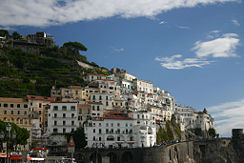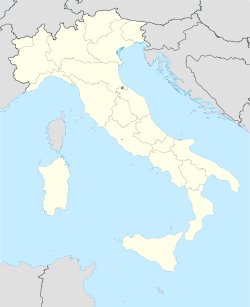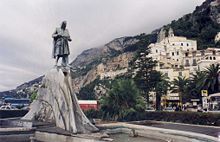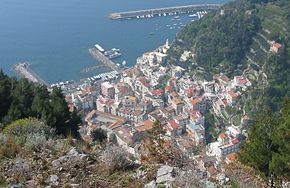Amalfi
- Amalfi is also a town in the Antioquia Departament in Colombia.
| Comune di Amalfi | |
|---|---|
 |
|
 |
|
| Country | |
| Region | Campania |
| Province | Salerno |
| Mayor | Antonio De Luca (centre-left; elected 28 May 2006) |
| Elevation | 6 m (20 ft) |
| Area | 6.11 km² (2.4 sq mi) |
| Population (as of December 31, 2004) | |
| - Total | 5,480 |
| - Density | 897/km² (2,323/sq mi) |
| Time zone | CET, UTC+1 |
| Coordinates | |
| Gentilic | amalfitani |
| Dialing code | 089 |
| Postal code | 84011 |
| Frazioni | Lone, Pastena, Vettica, Pogerola, Tovere |
| Patron | Saint Andrew |
| - Day | November 30 |
| Website: www.comune.amalfi.sa.it | |
Amalfi is a town and commune in the province of Salerno, in the region of Campania, Italy, on the Gulf of Salerno, 24 miles (39 km) southeast of Naples. It lies at the mouth of a deep ravine, at the foot of Monte Cerreto (1,315 meters, 4,314 feet), surrounded by dramatic cliffs and coastal scenery. The town of Amalfi was the capital of the Maritime Republic of Amalfi, an important trading power in the Mediterranean between 839 and around 1200.
In the 1920s and 1930s, Amalfi was a popular holiday destination for the British upper class and aristocracy.
Contents |
History
- See also Duchy of Amalfi and Archdiocese of Amalfi for the ecclesiastical history.
Amalfi is first mentioned in the 6th century, and soon acquired importance as a maritime power, trading grain of its neighbors,[1] salt from Sardinia[2] and slaves from the interior, and even timber, for the gold dinars minted in Egypt and Syria, in order to buy the silks of the Byzantine empire that it resold in the West. Grain-bearing Amalfi traders enjoyed privileged positions in the Islamic ports, Fernand Braudel notes. The Amalfi tables (Tavole Amalfitane) provided a maritime code that was widely used by the Christian port cities. Merchants of Amalfi were using gold coins to purchase land in the 9th century, while most of Italy worked in a barter economy. In the 8th and 9th century, when Mediterranean trade revived it shared with Gaeta the Italian trade with the East, while Venice was in its infancy, and in 848 its fleet went to the assistance of Pope Leo IV against the Saracens.


An independent republic from the seventh century until 1075, it rivalled Pisa and Genoa in its domestic prosperity and maritime importance, before the rise of Venice. In spite of some devastating setbacks it had a population of some 70,000, reaching an apogee about the turn of the millennium, during the reign of Duke Manso (966–1004). Under his line of dukes, Amalfi remained independent, except for a brief period of Salernitan dependency under Guaimar IV.
In 1073 it fell to the Norman countship of Apulia, but was granted many rights. A prey to the Normans who encamped in the south of Italy, it became one of their principal posts. However, in 1131, it was reduced by King Roger II of Sicily, who had been refused the keys to its citadel. The Holy Roman Emperor Lothair, fighting in favour of Pope Innocent II against Roger, who sided with the Antipope Anacletus, took him prisoner in 1133, assisted by forty-six Pisan ships. The city was sacked by the Pisans, commercial rivals of the Amalfitani; Lothair claimed as part of the booty a copy of the Pandects of Justinian which was found there.
In 1135 and 1137, it was taken by the Pisans and rapidly declined in importance, though its maritime code, known as the Tavole Amalfitane, was recognized in the Mediterranean until 1570. A tsunami in 1343 destroyed the port and lower town,[3] and Amalfi never recovered more than local importance.
In medieval culture Amalfi was famous for its flourishing schools of law and mathematics. Flavio Gioia, who is traditionally considered the first to introduce the mariner's compass to Europe, is said to be a native of Amalfi.
Main sites

Amalfi occupied a high position in medieval architecture; its cathedral of Sant' Andrea, of the eleventh century, the campanile, the convent of the Capuccini, founded by Cardinal Capuano, richly represent the artistic movement prevailing in Southern Italy at the time of the Normans, with its tendency to blend the Byzantine style with the forms and sharp lines of the northern architecture.
Burial place of Saint Andrew
In 1206 Saint Andrew's relics were brought to Amalfi from Constantinople by the Amalfitan Pietro, cardinal of Capua, following the Sack of Constantinople by the Crusaders after the completion of the town's cathedral.[4] The cathedral, dedicated to St. Andrew (as is the town itself), contains a tomb in its crypt that it maintains still holds a portion of the relics of the apostle. A golden reliquary which originally housed his skull and another one used for processions through Amalfi on holy days can also be seen.
During Mass on these holy days, St Andrew's relics are said to exude a liquid called "St. Andrew's Manna". The faithful are anointed with the liquid, and many believe it to be miraculous.
Today
Amalfi is the main town of the coast on which it is located, named Costiera Amalfitana, and is today an important tourist destination together with other towns on the same coast, such as Positano, Ravello and others. Amalfi is included in the UNESCO World Heritage Sites.
The Amalfi coast is famed for its production of Limoncello liqueur and home-made paper used throughout Italy for wedding invitations, visiting cards and elegant writing paper. The city is home to the Museo della Carta, a paper-making museum.
Three traditional events draw numerous visitors to Amalfi. First are the feast days of Saint Andrew (25-27 of June, and 30 November), celebrating the city's patron saint. Then there is "Byzantine New Year's Eve" (31 August) celebrating the beginning of the New Year according to the old civil calendar of the Byzantine Empire[5] The third event is the Ancient Regata (first Sunday in June), a traditional rowing competition among the four Sea Republics: Amalfi, Genova, Pisa, Venice. This event is hosted at every year by a different city, so it comes to Amalfi once every four years.
References
- ↑ Historians' usual association of Amalfi's early maritime trade arising from its position, pressed between the harbor and an infertile and mountainous circumscribed hinterland, forcing it into trading on the sea, is downplayed by M. del Treppo and A. Leone, Amalfi medioevale, 1977.
- ↑ Robert-Henri Bautier, "La marine d'Amalfi dans le traffic du méditerranéen du XIV siècle, à props du transport du sel de Sardaigne", Bulletin philologique et historique du Comité des Travaux historiques et scientifiques, noted in Fernand Braudel, The Perspective of the World, vol. III of Civilization and Capitalism (1984), sketching the economic history of Amalfi, pp 106-08.
- ↑ Braudel p. 107
- ↑ Buonaiuti, Ernesto (1907), "Amalfi", The Catholic Encyclopedia, I, New York: Robert Appleton Company, http://www.newadvent.org/cathen/01379a.htm, retrieved on 2008-03-14
- ↑ The Eastern Orthodox Church continues to celebrate the beginning of the liturgical year on September 1, a date chosen because of its proximity to the Jewish New Year.
See also
- Amalfian Laws
- Archdiocese of Amalfi
- Duchy of Amalfi
- Salerno Costa d'Amalfi Airport
Sources and external links
- Official Municipality web site
- Official Amalfi Coast Tourist Office
- Amalfi Webcam
- Amalfi Coast Newspaper
- Museum of Paper
- Information and news about Amalfi
- Travel guide to amalfi
- This article incorporates text from the public-domain Catholic Encyclopedia of 1913.
Campania · Comuni of the Province of Salerno  Acerno · Agropoli · Albanella · Alfano · Altavilla Silentina · Amalfi · Angri · Aquara · Ascea · Atena Lucana · Atrani · Auletta · Baronissi · Battipaglia · Bellizzi · Bellosguardo · Bracigliano · Buccino · Buonabitacolo · Caggiano · Calvanico · Camerota · Campagna · Campora · Cannalonga · Capaccio · Casal Velino · Casalbuono · Casaletto Spartano · Caselle in Pittari · Castel San Giorgio · Castel San Lorenzo · Castelcivita · Castellabate · Castelnuovo Cilento · Castelnuovo di Conza · Castiglione del Genovesi · Cava de' Tirreni · Celle di Bulgheria · Centola · Ceraso · Cetara · Cicerale · Colliano · Conca dei Marini · Controne · Contursi Terme · Corbara · Corleto Monforte · Cuccaro Vetere · Eboli · Felitto · Fisciano · Furore · Futani · Giffoni Sei Casali · Giffoni Valle Piana · Gioi · Giungano · Ispani · Laureana Cilento · Laurino · Laurito · Laviano · Lustra · Magliano Vetere · Maiori · Mercato San Severino · Minori · Moio della Civitella · Montano Antilia · Monte San Giacomo · Montecorice · Montecorvino Pugliano · Montecorvino Rovella · Monteforte Cilento · Montesano sulla Marcellana · Morigerati · Nocera Inferiore · Nocera Superiore · Novi Velia · Ogliastro Cilento · Olevano sul Tusciano · Oliveto Citra · Omignano · Orria · Ottati · Padula · Pagani · Palomonte · Pellezzano · Perdifumo · Perito · Pertosa · Petina · Piaggine · Pisciotta · Polla · Pollica · Pontecagnano Faiano · Positano · Postiglione · Praiano · Prignano Cilento · Ravello · Ricigliano · Roccadaspide · Roccagloriosa · Roccapiemonte · Rofrano · Romagnano al Monte · Roscigno · Rutino · Sacco · Sala Consilina · Salento · Salerno · Salvitelle · San Cipriano Picentino · San Giovanni a Piro · San Gregorio Magno · San Mango Piemonte · San Marzano sul Sarno · San Mauro Cilento · San Mauro la Bruca · San Pietro al Tanagro · San Rufo · San Valentino Torio · Sant'Angelo a Fasanella · Sant'Arsenio · Sant'Egidio del Monte Albino · Santa Marina · Santomenna · Sanza · Sapri · Sarno · Sassano · Scafati · Scala · Serramezzana · Serre · Sessa Cilento · Siano · Sicignano degli Alburni · Stella Cilento · Stio · Teggiano · Torchiara · Torraca · Torre Orsaia · Tortorella · Tramonti · Trentinara · Valle dell'Angelo · Vallo della Lucania · Valva · Vibonati · Vietri sul Mare
Acerno · Agropoli · Albanella · Alfano · Altavilla Silentina · Amalfi · Angri · Aquara · Ascea · Atena Lucana · Atrani · Auletta · Baronissi · Battipaglia · Bellizzi · Bellosguardo · Bracigliano · Buccino · Buonabitacolo · Caggiano · Calvanico · Camerota · Campagna · Campora · Cannalonga · Capaccio · Casal Velino · Casalbuono · Casaletto Spartano · Caselle in Pittari · Castel San Giorgio · Castel San Lorenzo · Castelcivita · Castellabate · Castelnuovo Cilento · Castelnuovo di Conza · Castiglione del Genovesi · Cava de' Tirreni · Celle di Bulgheria · Centola · Ceraso · Cetara · Cicerale · Colliano · Conca dei Marini · Controne · Contursi Terme · Corbara · Corleto Monforte · Cuccaro Vetere · Eboli · Felitto · Fisciano · Furore · Futani · Giffoni Sei Casali · Giffoni Valle Piana · Gioi · Giungano · Ispani · Laureana Cilento · Laurino · Laurito · Laviano · Lustra · Magliano Vetere · Maiori · Mercato San Severino · Minori · Moio della Civitella · Montano Antilia · Monte San Giacomo · Montecorice · Montecorvino Pugliano · Montecorvino Rovella · Monteforte Cilento · Montesano sulla Marcellana · Morigerati · Nocera Inferiore · Nocera Superiore · Novi Velia · Ogliastro Cilento · Olevano sul Tusciano · Oliveto Citra · Omignano · Orria · Ottati · Padula · Pagani · Palomonte · Pellezzano · Perdifumo · Perito · Pertosa · Petina · Piaggine · Pisciotta · Polla · Pollica · Pontecagnano Faiano · Positano · Postiglione · Praiano · Prignano Cilento · Ravello · Ricigliano · Roccadaspide · Roccagloriosa · Roccapiemonte · Rofrano · Romagnano al Monte · Roscigno · Rutino · Sacco · Sala Consilina · Salento · Salerno · Salvitelle · San Cipriano Picentino · San Giovanni a Piro · San Gregorio Magno · San Mango Piemonte · San Marzano sul Sarno · San Mauro Cilento · San Mauro la Bruca · San Pietro al Tanagro · San Rufo · San Valentino Torio · Sant'Angelo a Fasanella · Sant'Arsenio · Sant'Egidio del Monte Albino · Santa Marina · Santomenna · Sanza · Sapri · Sarno · Sassano · Scafati · Scala · Serramezzana · Serre · Sessa Cilento · Siano · Sicignano degli Alburni · Stella Cilento · Stio · Teggiano · Torchiara · Torraca · Torre Orsaia · Tortorella · Tramonti · Trentinara · Valle dell'Angelo · Vallo della Lucania · Valva · Vibonati · Vietri sul Mare